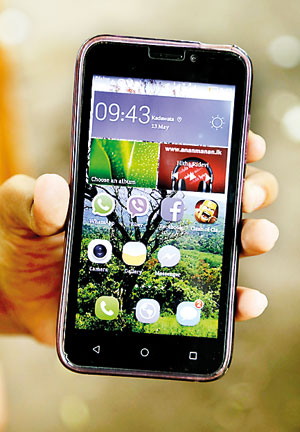News
Mobiles won’t cause lightning deaths, expert says
 The tragic death of 17-year-old schoolboy Thilinda Chamika this week raised anxiety over the use of mobile phones during lightning as it was initially suspected that the victim had succumbed to a lightning strike.
The tragic death of 17-year-old schoolboy Thilinda Chamika this week raised anxiety over the use of mobile phones during lightning as it was initially suspected that the victim had succumbed to a lightning strike.
It is still unclear whether lightning did play a part in the tragedy or whether it was a case of electrocution due to a technical fault in the power socket.
Experts have stressed there is no danger in using mobile phones during times of lightning, provided they are not connected to chargers. In fact, they say, using landlines is far more dangerous during a storm.
Senior Lecturer at the Colombo University’s Department of Physics Dr. Mahendra Fernando says there is no danger of lightning being attracted to mobile phones. Dr. Fernando, who specialises in the physics of lightning and lightning protection, explained that the process of lightning starts from the clouds and comes to the ground via a “stepped leader”.
A stepped leader is the initial streamer of lightning discharge from a thundercloud. As the stepped leader approaches the ground, objects that are closest to the base of the thundercloud, such as trees, hills and tall buildings, send out connecting leaders towards the stepped leader, attracting lightning. If one of these leaders from the ground connects with the stepped leader, a lightning strike is created.
A mobile phone, however, is an extremely small device and is not able to send out a connecting leader by itself, Dr. Fernando stated.
“The issue is many people believe that microwaves generated by mobile phones ionise the air and this ionisation in turn attracts the lightning, but this doesn’t happen as the microwaves emitted by mobile phones are extremely low. They are not at all enough to ionise the air,” he said.
Ionisation is the process in which an atom or molecule acquires a positive charge (by losing electrons) or negative charge (by gaining electrons).
If, however, a person is using the mobile phone in an open space where he or she is the tallest structure in that open space, can send out a connecting leader that attracts lightning. If someone is struck by lightning while in an open space and happened to be using a mobile phone at the time, it creates the impression that it was the mobile phone that attracted the lightning.
Dr. Fernando emphasised there was no danger of using a mobile phone or cordless phone inside a house during lightning, “so long as they are not plugged into an electrical charger”. This was because a lightning strike could enter the house through the power lines.
The case was different when using fixed landline phones. Using a landline during lightning strikes was extremely dangerous as lightning can travel through the phone lines.
“In fact, the advice we can give is to encourage people to use mobile phones rather than landlines if you want to communicate in the event there is lightning,” Dr. Fernando stressed.
The former director of the Department of Meteorology, K.R. Abeysinghe, warned of lightning hazards.
“If thunderstorms are active and you are outside, the best precaution is to find shelter in a safe place to avoid exposing yourself to the open air. If the time interval between a lightning flash and hearing thunder becomes less than 15 seconds, you should move quickly to a protected location, as there is immediate danger of a lightning strike nearby,” he stressed.
Indoors, precautions should be taken, including keeping electrical appliances disconnected from the main supply line, disconnecting television antennas from television sets and placing the antenna socket outside close to the earth, avoiding touching tall metal structures and not using fixed line telephones during thunderstorms should be taken.
People who are caught outdoors during lightning storms should avoid loitering in open areas such as paddy fields, tea estates or playgrounds. They should especially avoid working with metal tools such as mammoties, knives or iron rods.
“If this cannot be avoided, crouch down [individually] with feet together. Footwear or a layer of any non-absorbing material, such as plastic sheet, will offer some protection against ground currents,” Mr. Abeysinghe said.
Other things to avoid include seeking shelter under tall trees or on high ground and riding bicycles or any open vehicles such as tractors.
The Department of Meteorology issued a severe weather warning on Friday evening, stating that the atmospheric disturbance in the vicinity of Sri Lanka was likely to intensify this weekend. It would move gradually to a depression and come closer to Sri Lanka.
Under its influence, strong winds and heavy rainfall can be expected over the country and surrounding sea areas during May 15-18. “Very heavy rain falls are also expected particularly over Southwestern part of the country,” the weather warning bulletin said.
| Lightning bolt takes a life and leaves a hundred questions By Kasun Warakapitiya
Thilinda’s 21-year-old sister, Savithra Dilrukshi Weerasinghe, the sole witness to what happened, is unable to control her emotions as she recounts how her brother was struck down. At about 6.30 p.m. on that fateful day the two had been alone at home sitting on a bed and looking at messages that Thilinda was showing his sister on his mobile phone. It was raining heavily at the time, with thunder and lightning. Suddenly there was loud burst of thunder with a flash of light that momentarily blinded them. “I closed my eyes and ears and when I opened my eyes my brother was standing up and taking a few steps. He had tossed the phone to the bed and was saying “Akki, Akki, my hands are going numb’,” she recalled. At first, she thought her brother was playing a prank on her. “He then collapsed on the floor and curled up in a ball. I hugged him and cried, and for five minutes yelled for help from neighbours,” she said. She ran outside to find a vehicle and within 15 minutes her brother was taken to hospital – but he was pronounced dead on arrival.  Thilinda's mobile phone She said at that time the phone charger was plugged into the wall socket, which later was found to have a power leak. The charger was not, however, connected to the mobile phone that had been in the victim’s hand at the time of the tragedy. “The bed we were sitting on has a metal frame and the pin end of the charger was on the bed. It is possible that this touched my brother’s hand and he was electrocuted,’ she said. A postmortem carried out by Ragama Hospital Judicial Medical Officer S.D. Ganghawatte declared death had been caused by electrocution. |


 The family of 17-year-old schoolboy Thilinda Chamika is still in disbelief about the tragedy that struck the youth, who died due to electrocution triggered by lightning on Tuesday.
The family of 17-year-old schoolboy Thilinda Chamika is still in disbelief about the tragedy that struck the youth, who died due to electrocution triggered by lightning on Tuesday.